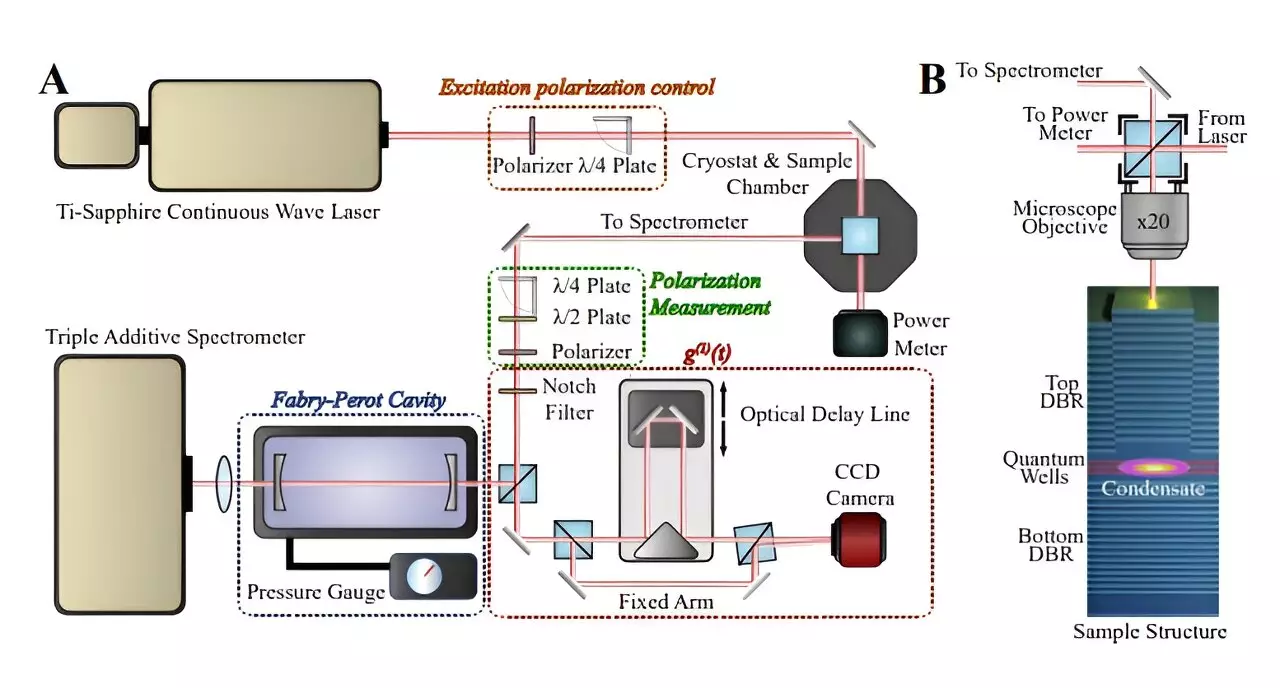In a groundbreaking experiment conducted by researchers from the Paul-Drude-Institute for Solid State Electronics in Berlin, Germany, and the Centro Atómico Bariloche and Instituto Balseiro in Argentina, a time crystal has been observed on a microscale semiconductor chip. This observation revealed exceptional non-linear dynamics in the GHz range, pushing the boundaries of current understanding in the field. The results, published in Science, demonstrate a novel connection between non-linear exciton-polariton dynamics and coherent optomechanics at frequencies previously unexplored.
The experiment involved using a high-quality semiconductor-based sample designed and fabricated at PDI. This sample acted as a trap for coherent light-matter condensates, allowing researchers to study the behavior of quantum particles in a controlled environment. By stacking one-atom-thick layers of semiconductor materials under ultrahigh vacuum conditions, the researchers created a micron-sized “box” capable of trapping millions of quantum particles. When a continuous laser was directed at the sample, the particles inside began oscillating at GHz frequencies, marking the first sustained oscillations of this kind in a semiconductor device.
Researchers discovered that the oscillations of the particles could be finely adjusted by varying the laser’s optical power. Additionally, by introducing 20-GHz mechanical vibrations of the semiconductor atomic lattice, the researchers were able to stabilize the frequency of the oscillations. The particles displayed behavior characteristic of a time crystal, with vibrations occurring at exactly half the frequency of the mechanical vibrations. These findings represent a significant advancement in the field of many-body quantum systems, offering insights into high-frequency dynamics and control mechanisms.
Since physicist Frank Wilczek first proposed the concept of time crystals over a decade ago, scientists have been intrigued by the possibility of observing periodic temporal oscillations in many-body systems. While time crystals were initially thought to be impossible in isolated systems, recent experiments conducted in open systems have provided new insights into their behavior. The observation of time crystals on a semiconductor platform opens up avenues for studying their interactions and synchronization in large arrays, shedding light on the mysterious internal dynamics of quantum materials.
The implications of this research extend beyond theoretical discoveries, with potential applications in integrated and microwave photonics. The enhanced coupling between GHz phonons and near-infrared photons in semiconductor-based systems holds promise for quantum conversion between different frequencies. By harnessing the unique properties of time crystals, researchers aim to develop photon-to-radiofrequency conversion technologies for classical and quantum information processing. The compatibility of semiconductor materials with integrated photonic devices further facilitates the integration of time crystals into practical applications.
As the field of time crystal research continues to evolve, researchers are optimistic about the prospects of utilizing these quantum phenomena in optoelectronic systems. The intricate dynamics of time crystals offer insights into the behavior of complex many-body systems, paving the way for innovative technologies in on-chip photonics. By gaining a deeper understanding of the internal dynamics of semiconductor-based systems, researchers hope to develop novel methods for controlling and utilizing time crystals for practical applications in various industries.
The discovery of a time crystal on a semiconductor chip represents a significant milestone in the study of quantum phenomena. By bridging the gap between non-linear dynamics and optomechanics at GHz frequencies, researchers have unlocked new possibilities for controlling and manipulating time crystals for future technological advancements. As the field continues to expand, further research into the behavior and applications of time crystals is expected to drive innovation in quantum information processing and integrated photonics.


Leave a Reply